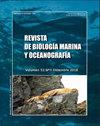海岸上升流对智利中部瓦尔帕莱索湾(~33ºS)微型浮游植物变化的影响
IF 0.5
4区 生物学
Q4 MARINE & FRESHWATER BIOLOGY
引用次数: 0
摘要
在这项工作中,来自位于瓦尔帕莱索湾北部的一个固定站的10年数据(1986-1996年)(33000年;分析了沿海上升流活动对微浮游植物(20 ~ 200 μm)时间变化的影响及其与海洋条件的关系。海湾的上升流活动与半年一次的风势有关,9 - 3月有利于上升流的南西南风增强,4 - 8月下升流减弱并出现。海洋学条件显示,春季(9 - 11月)冷而富营养的咸水上升。而在上升流指数最高的夏季,则记录了热分层条件。这种分层可能与太阳辐射或海湾内上升流阴影区的存在有关。上升流期微浮游植物丰度最高,以硅藻为主。这一时期与海湾生物量和丰富度的增加有关。与此同时,在非上升流时期,在温度、盐度和营养条件均匀的情况下,发现与鞭毛藻和硅鞭毛藻相关的多样性增加(但丰度和丰富度较低)。因此,研究结果表明,在与局地风强迫和混合/分层有关的海洋条件变化的响应下,海湾中存在一种双峰态的微型浮游植物。本文章由计算机程序翻译,如有差异,请以英文原文为准。
Influence of coastal upwelling on micro-phytoplankton variability at Valparaíso Bay (~33ºS), Central Chile
In this work 10 years of data (1986-1996) from a fixed station located in the northern part of Valparaiso Bay (33o00’S; 71o35’W) were analysed to study the influence of coastal upwelling activity on the temporal variation of micro-phytoplankton (20-200 μm) and their relationship with oceanographic conditions. The upwelling activity at the bay was associated to semi-annual wind regime with an intensification of upwelling-favourable S-SW winds from September to March followed by a decrease and the occurrence of downwelling events from April to August. Oceanographic conditions showed the ascent of cold, nutrient-rich salty water in spring (September-November). However, during summertime under highest upwelling index, thermal stratification conditions were registered. This stratification might be associated to either the solar radiation or the presence of an upwelling shadow area in the bay. The upwelling period had the highest micro-phytoplankton abundance mainly dominated by diatoms. This period was associated with an increase in biomass and richness in the bay. Meanwhile during non-upwelling period —under homogenous conditions of temperature, salinity and nutrients— an increase in diversity (but low abundance and richness) associated to dinoflagellates and silicoflagellates was noted. Therefore, the results suggest the presence of a bi-modal regime of micro-phytoplankton in the bay in response to changes in oceanographic conditions related to local wind forcing and mixing/stratification.
求助全文
通过发布文献求助,成功后即可免费获取论文全文。
去求助
来源期刊
CiteScore
0.70
自引率
0.00%
发文量
41
审稿时长
12 months
期刊介绍:
Publicar desde una perspectiva científica, artículos originales, decididos por un proceso de revisión por pares, invitando a expertos de reconocido prestigio en el área. Los trabajos publicados se caracterizarán por su solidez teórica-metodológica, actualidad y relevancia para las ciencias marinas.
Se reciben trabajos inéditos derivados de la investigación científica realizada en ambientes marinos y estuarios, en formato de Revisión, Artículos, Notas Científicas, y Obituarios en las siguientes disciplinas::
Biología-Ecología marina
Oceanografía física, química y biológica
Contaminación marina
Geología marina
Sistemática, Faunística y Biogeografía Marina
Manejo Costero
Acuicultura marina
Pesquería marina.

 求助内容:
求助内容: 应助结果提醒方式:
应助结果提醒方式:


